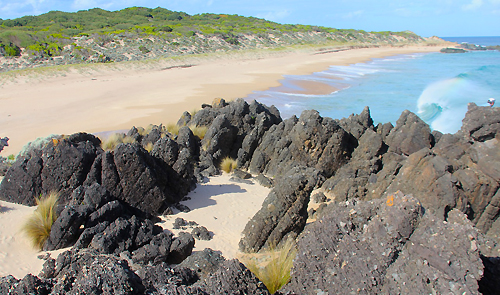Ocean Oxidation and the Biosphere During Neoproterozoic Glaciation
 An increase in oxygen levels has long been invoked as a driver of biological innovation during the Neoproterozoic Era. Recent work suggests that a pulse in oxygenation ca. 580 Ma may have permitted the evolution of the Ediacara Biota, but little consideration has been paid to the relationship between biology and fluctuating oxygen levels earlier in the Neoproterozoic, in particular spanning the Cryogenian (aka ‘snowball Earth’) glaciations. The aim of this project is two-fold: (1) reconstruct redox conditions and biology during the Cryogenian glacial interval; and (2) test the hypothesis that fluctuating oxygen levels are linked to changes in the diversity and composition of biological communities during this time. This project, being led by Susannah Porter (UCSB) and Matt Hurtgen (Northwestern University) involves combining micropaleontological, δ34S, Fe speciation, TOC, and trace element analyses of shales collected from successions in Svalbard and four separate basins in Australia (NW Tasmania, Adelaide Rift-basin, eastern Officer basin, Amadeus basin), which collectively span the entire interval of Cryogenian glaciation. Because all analyses are being performed on the same suite of stratigraphically well-defined samples, records of life and oxygen availability will be unambiguously linked and placed within the context of Neoproterozoic climate change.
An increase in oxygen levels has long been invoked as a driver of biological innovation during the Neoproterozoic Era. Recent work suggests that a pulse in oxygenation ca. 580 Ma may have permitted the evolution of the Ediacara Biota, but little consideration has been paid to the relationship between biology and fluctuating oxygen levels earlier in the Neoproterozoic, in particular spanning the Cryogenian (aka ‘snowball Earth’) glaciations. The aim of this project is two-fold: (1) reconstruct redox conditions and biology during the Cryogenian glacial interval; and (2) test the hypothesis that fluctuating oxygen levels are linked to changes in the diversity and composition of biological communities during this time. This project, being led by Susannah Porter (UCSB) and Matt Hurtgen (Northwestern University) involves combining micropaleontological, δ34S, Fe speciation, TOC, and trace element analyses of shales collected from successions in Svalbard and four separate basins in Australia (NW Tasmania, Adelaide Rift-basin, eastern Officer basin, Amadeus basin), which collectively span the entire interval of Cryogenian glaciation. Because all analyses are being performed on the same suite of stratigraphically well-defined samples, records of life and oxygen availability will be unambiguously linked and placed within the context of Neoproterozoic climate change.
Most samples for the project have already been collected and being processed by PhD student Leigh Anne Riedman (UCSB) and post-doc Chris Junium (Northwestern University).
This project is supported by the National Science Foundation (Sedimentary Geology & Paleobiology)